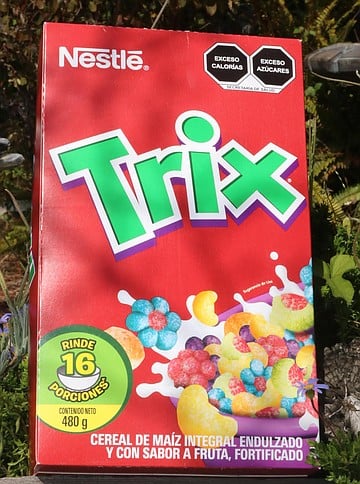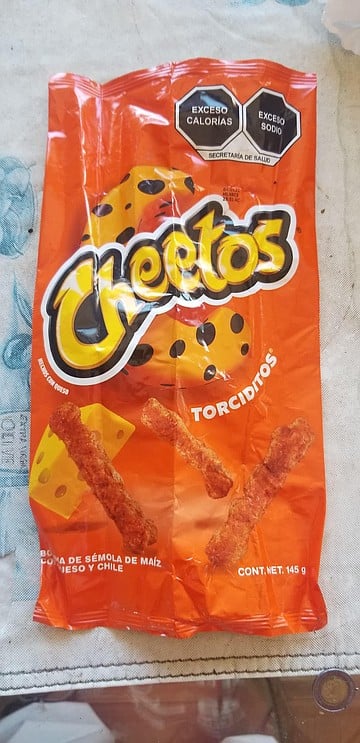 Facebook
Facebook
 X
X
 Instagram
Instagram
 TikTok
TikTok
 Youtube
Youtube

I asked Duane D what's the most expensive cereal box that he owns?
"It's probably worth $20,000. I have the first Michael Jordan progressive proof Wheaties box set that's white in color."

I met up with Duane and his cereal box connection, Pedro Tarref, by Mission Bay on March 7.
"Please, no pictures of us," Tarref requested, ".... only the cereal boxes."
Tarref and Duane are cereal box and cereal toy collectors. "What do you have for me this week?" Duane asked Tarref.
"I brought Mexican boxes of Trix, Frosted Flakes, which they call Zukaritas, and Lucky Charms."
"Where's Tricks the Rabbit, Tony the Tiger, and Lucky the Leprechaun?" I asked the two.
"The Mexican government 86ed the cartoon characters on cereal boxes," Tarref explained, "and instead, added these octagon symbols."
I excused myself while the two negotiated prices for the ten or so boxes Tarref purchased from a Mexicali supermercado for about $2 apiece. I hopped onto my phone then Googled cajas de cereal en Mexico. The El Universal news outlet explained further what the two cereal-heads were negotiating about.

"Después de Chester Cheetos, desaparecen a 'Tigre Toño,' 'Melvin' y 'Sam' de cajas de cereal," read the headline of the January 30 published story that translates to "After Chester Cheetos, [Tony the] Tiger Toño, Melvin and [Toucan] Sam disappear from cereal boxes."
According to the news report, the removal of cartoon characters from cereal boxes is part of the new Official Mexican Standard NOM-051-SCFI/SSA-2010 general labeling specifications for prepackaged food and non-alcoholic beverages. The specs were issued by the Secretariats of Health and Economy department, in compliance with PROFECO, Office of the Federal Prosecutor for the Consumer. The provision applies to products' packaging depicting one or more (octagon-shaped) warning labels: excess sugar, excess fat, excess sodium, excess calories, and excess saturated fat.
The new labeling standard went into effect on October 1, and the supermarkets and stores have until April 1 to get rid of products with older cartoon emblazoned packaging.
"How will this change the collectible cereal market?" I asked the two.
Duane said "It will probably take 20-30 years for these no character anomalies to be worth more than what was paid for them."
Tarref disagreed. "They're worth about $10-$15 in the U.S. now."
On a quick search on U.S. eBay, I couldn't find a vendor selling the characterless Mexican cereal boxes. On Amazon — a U.S.-based vendor was selling boxes of Choco Krispis, with Melvin the elephant supposedly still depicted on the box art — for $20.99 plus $8.75 for shipping and handling. "The photo with Melvin on the box did not arrive as expected; it came out different," reviewed one customer. "The sad thing is that I ordered it for the photo of Melvin, and it was not like that." Another customer agreed.
Tarref owns a Ghostbusters cereal box from the 1980s worth about $100 and a Mexican Star Wars cereal box from the 1990s that's worth about $25. "I eat all of the cereal and store my boxes flat."
Duane, who has diabetes, pulls the toy premiums from the cereal, zip-locks the cereal, returns the bagged cereal to Tarref, and displays the empty boxes and plastic toys on a shelf.
"How does the Mexican cereal taste compared to U.S. cereal? I asked Tarref.
"It has a different sugar flavor, and they are a bit more fragile in structure."
"It's not just cereals that are affected by the new protocol," Rosarito reporter Diego Knight said to me on March 21. "Check out this bag of Cheetos I just ate."
The empty orange and blue colored bag was missing the Chester Cheetah image.
"They are also doing this with cookies, candies, bread, juices, sodas, and chocolate milk."
"This new type of labeling protocol started in Brazil and Chile a couple of years ago, and it's now Mexico," Duane said to me. "We brought back cereal boxes from there as well."
"Based on the Chilean model, NOM (Official Mexican Standard) 051 states that a warning label must be used on the packaging, which will be placed in the upper right part of the main surface of the packaging," Milenio.com explained in an October report. "In those products with the main display area of less than 60 cm., the stamps may be placed in any area. Products marketed in Mexico (national or foreign) are required to comply with this provision. Labels should state whether a product has excess calories, sodium, trans fats, sugars, and saturated fats. Unlike the Chilean regulation, in Mexico, products that contain sweeteners or caffeine are required to have a legend that specifies the presence of these and 'avoid or not recommended in children.'"
The news report added that an estimated "85 percent of products packaged in Mexico" will have some warning label, and non-compliant companies "will be fined 781,920 pesos (about $37,788)" and their merchandise immobilized.
"The new regulation also states that prepackaged products that bear one or more warning labels may not include celebrities, athletes, cartoon characters, and pets; interactive elements such as games on the packaging; digital downloads, all of which are aimed at children, to incite and promote or encourage the consumption, purchase or choice of products with excess citrus nutrients or sweeteners."
According to unicef.org, "in 2016, Mexico declared an epidemiological alert due to the high rates of diabetes and obesity. One-third of Mexican children and adolescents are overweight or obese. This is by no means a coincidence, as Mexico is the largest consumer of ultra-processed products, including sugary drinks, in Latin America. The highest consumption rates are among preschoolers who receive about 40 percent of their calories from these products."


I asked Duane D what's the most expensive cereal box that he owns?
"It's probably worth $20,000. I have the first Michael Jordan progressive proof Wheaties box set that's white in color."

I met up with Duane and his cereal box connection, Pedro Tarref, by Mission Bay on March 7.
"Please, no pictures of us," Tarref requested, ".... only the cereal boxes."
Tarref and Duane are cereal box and cereal toy collectors. "What do you have for me this week?" Duane asked Tarref.
"I brought Mexican boxes of Trix, Frosted Flakes, which they call Zukaritas, and Lucky Charms."
"Where's Tricks the Rabbit, Tony the Tiger, and Lucky the Leprechaun?" I asked the two.
"The Mexican government 86ed the cartoon characters on cereal boxes," Tarref explained, "and instead, added these octagon symbols."
I excused myself while the two negotiated prices for the ten or so boxes Tarref purchased from a Mexicali supermercado for about $2 apiece. I hopped onto my phone then Googled cajas de cereal en Mexico. The El Universal news outlet explained further what the two cereal-heads were negotiating about.

"Después de Chester Cheetos, desaparecen a 'Tigre Toño,' 'Melvin' y 'Sam' de cajas de cereal," read the headline of the January 30 published story that translates to "After Chester Cheetos, [Tony the] Tiger Toño, Melvin and [Toucan] Sam disappear from cereal boxes."
According to the news report, the removal of cartoon characters from cereal boxes is part of the new Official Mexican Standard NOM-051-SCFI/SSA-2010 general labeling specifications for prepackaged food and non-alcoholic beverages. The specs were issued by the Secretariats of Health and Economy department, in compliance with PROFECO, Office of the Federal Prosecutor for the Consumer. The provision applies to products' packaging depicting one or more (octagon-shaped) warning labels: excess sugar, excess fat, excess sodium, excess calories, and excess saturated fat.
The new labeling standard went into effect on October 1, and the supermarkets and stores have until April 1 to get rid of products with older cartoon emblazoned packaging.
"How will this change the collectible cereal market?" I asked the two.
Duane said "It will probably take 20-30 years for these no character anomalies to be worth more than what was paid for them."
Tarref disagreed. "They're worth about $10-$15 in the U.S. now."
On a quick search on U.S. eBay, I couldn't find a vendor selling the characterless Mexican cereal boxes. On Amazon — a U.S.-based vendor was selling boxes of Choco Krispis, with Melvin the elephant supposedly still depicted on the box art — for $20.99 plus $8.75 for shipping and handling. "The photo with Melvin on the box did not arrive as expected; it came out different," reviewed one customer. "The sad thing is that I ordered it for the photo of Melvin, and it was not like that." Another customer agreed.
Tarref owns a Ghostbusters cereal box from the 1980s worth about $100 and a Mexican Star Wars cereal box from the 1990s that's worth about $25. "I eat all of the cereal and store my boxes flat."
Duane, who has diabetes, pulls the toy premiums from the cereal, zip-locks the cereal, returns the bagged cereal to Tarref, and displays the empty boxes and plastic toys on a shelf.
"How does the Mexican cereal taste compared to U.S. cereal? I asked Tarref.
"It has a different sugar flavor, and they are a bit more fragile in structure."
"It's not just cereals that are affected by the new protocol," Rosarito reporter Diego Knight said to me on March 21. "Check out this bag of Cheetos I just ate."
The empty orange and blue colored bag was missing the Chester Cheetah image.
"They are also doing this with cookies, candies, bread, juices, sodas, and chocolate milk."
"This new type of labeling protocol started in Brazil and Chile a couple of years ago, and it's now Mexico," Duane said to me. "We brought back cereal boxes from there as well."
"Based on the Chilean model, NOM (Official Mexican Standard) 051 states that a warning label must be used on the packaging, which will be placed in the upper right part of the main surface of the packaging," Milenio.com explained in an October report. "In those products with the main display area of less than 60 cm., the stamps may be placed in any area. Products marketed in Mexico (national or foreign) are required to comply with this provision. Labels should state whether a product has excess calories, sodium, trans fats, sugars, and saturated fats. Unlike the Chilean regulation, in Mexico, products that contain sweeteners or caffeine are required to have a legend that specifies the presence of these and 'avoid or not recommended in children.'"
The news report added that an estimated "85 percent of products packaged in Mexico" will have some warning label, and non-compliant companies "will be fined 781,920 pesos (about $37,788)" and their merchandise immobilized.
"The new regulation also states that prepackaged products that bear one or more warning labels may not include celebrities, athletes, cartoon characters, and pets; interactive elements such as games on the packaging; digital downloads, all of which are aimed at children, to incite and promote or encourage the consumption, purchase or choice of products with excess citrus nutrients or sweeteners."
According to unicef.org, "in 2016, Mexico declared an epidemiological alert due to the high rates of diabetes and obesity. One-third of Mexican children and adolescents are overweight or obese. This is by no means a coincidence, as Mexico is the largest consumer of ultra-processed products, including sugary drinks, in Latin America. The highest consumption rates are among preschoolers who receive about 40 percent of their calories from these products."
Comments